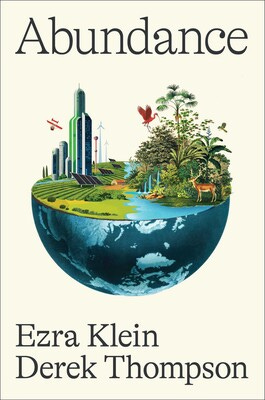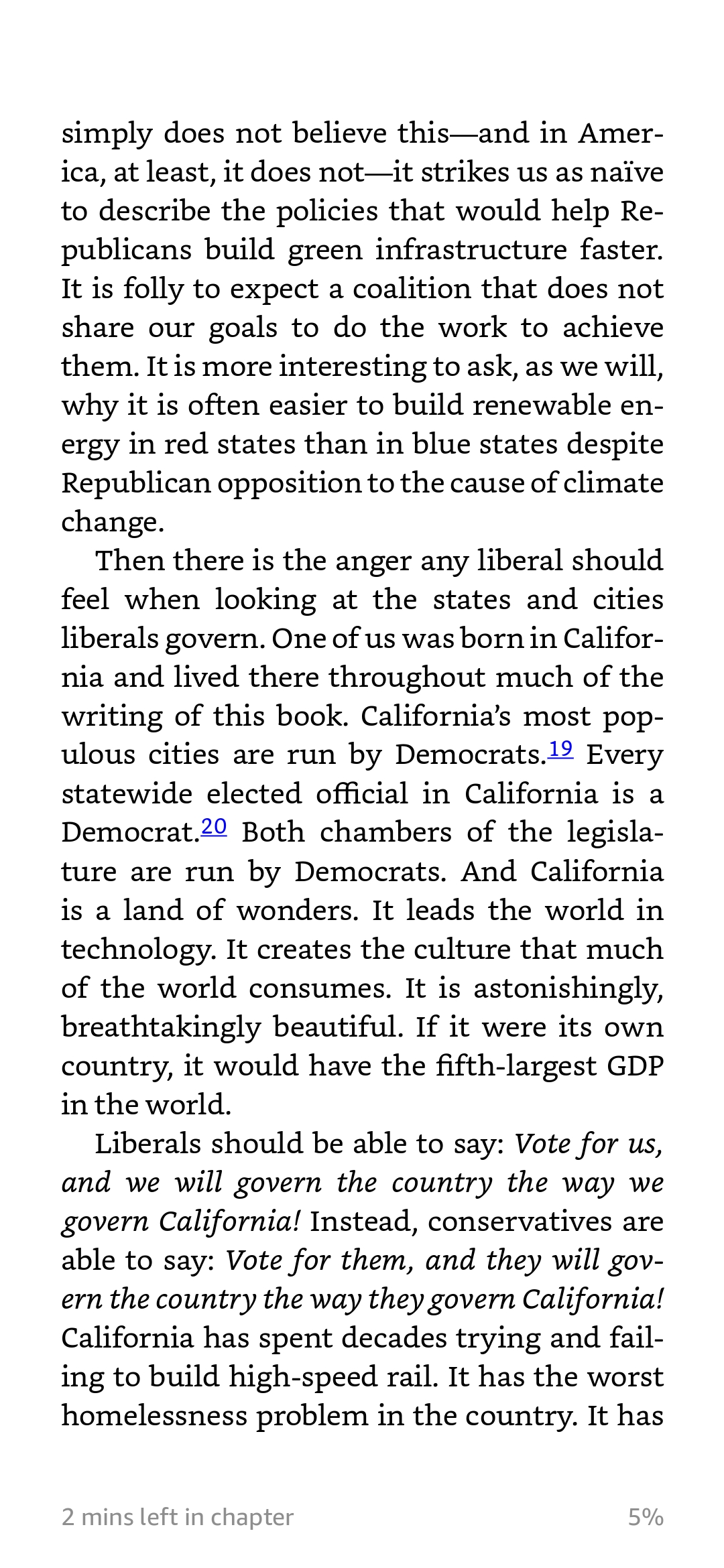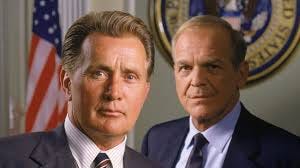What Do Microeconomists Know About Producing "Abundance"?
Insights from Friedman's Capitalism and Freedom
On a recent airplane ride, I read an important new book titled *Abundance*. In this Substack, I will provide a high-level overview of some of the authors' arguments. However, I wouldn’t classify this as a book review, as it would be unfair to the authors to label it as such.
Abundance begins by sketching out a vision for what life could be like in the year 2050 for a middle-class family living in American cities, perhaps in locations like Boston, Cleveland, or Portland. The authors depict a future filled with blue skies and greenery, reminiscent of the futuristic television show *The Jetsons*, illustrating an idealized version of a truly green city with no local emissions and a complete shift toward an electrified economy, including transportation and housing.
The cities described are the kind that climate advocates like Greta Thunberg and Al Gore would love. The vision is for these cities and neighborhoods to be built have between now and 2050, resulting in greater abundance. Infrastructure would be updated, highways rebuilt, and smart networks would be established to collect data. This scenario represents an engineer's dream of reimagining American cities constructed using local labor and designed to minimize carbon footprints.
According to the authors, the electrification of every sector of the economy will be powered by low-carbon energy sources, leading to reduced local air pollution and minimized greenhouse gas emissions. Middle-class construction jobs are anticipated to contribute to the development of these cities, leading to a higher quality of life.
The authors emphasize the housing sector and the challenge of climate change. They argue that the United States, particularly in blue states like Oregon and California and in blue cities such as Boston, San Francisco, and Berkeley, has not built enough housing and continues to emit excessive greenhouse gases.
To the authors’ credit, they emphasize that Big Blue Cities have had “bad rules” that have slowed down the abundance agenda. Here is a page of their book that I really like!
When the authors think of "abundance," they focus on the challenges of executing infrastructure and construction projects in the United States. They reference a concept from economics concerning supply and demand, where a vertical supply curve illustrates that, even when offered a higher price, the quantity produced remains relatively unchanged. In contrast, a flatter supply curve indicates that suppliers can significantly increase output when incentives are adjusted, leading to abundant goods.
Consider this graph. As demand increases (perhaps due to income growth or population growth, supply does not increase. This is the NO ABUNDANCE case. In this case market prices rise for this scarce good and this lowers the purchasing power of the middle class and poorer people!
Here is the ABUNDANCE CASE!
In this case, increases in demand do not raise market prices. Instead, more stuff gets built!!
This differentiation in supply curve shapes may sound technical, but it plays a crucial role in determining whether abundance is achievable. In a supply and demand framework, as demand increases—be it for Big Mac burgers or housing—it's essential to observe how the supply side responds. If the supply curve is vertical, an increase in demand might cause prices to rise significantly due to the fixed amount of supply. In the 2nd case, Suppliers respond to rising demand by producing more and note that prices barely rise. In that case, more middle-class individuals can access the good (perhaps housing, or green power). Middle class prosperity increases!
The key question posed by this book (that it doesn’t answer!) is what rules of the game could lead to greater overall abundance and allow the middle class to benefit more from economic growth?
The authors don’t delve into the ideas of Milton Friedman and the neoclassical economists often labeled as "neoliberals." For instance, his influential work, "Capitalism and Freedom," from 1962, is not mentioned. Friedman stressed that Abundance will only be achieved by the government retreating from major markets that I discuss below. The authors of this book embrace a “smarter Government” approach (think of Martin Sheen as our President in the TV show The West Wing). Friedman and Ezra Klein appear to strongly disagree on what role government should play here in bringing about abundance.
How fascinating it would be if Milton Friedman had collaborated with these authors on this project! It could have presented a well-rounded view of how we can achieve prosperity.
Friedman and the authors would disagree on several points. Friedman would sharply reduce the minimum wage and would abolish all of the subsidies embodied in “Green legislation” such as the Inflation Reduction Act. Friedman would support rules for allowing prices to freely float to signal scarcity. Friedman would empower the poor to make their own choices and would eliminate the government’s role as a benovelent paternalist. At the same time, Friedman would enact rules that increase the opportunities for the poor to pursue their own vision “of the good life”.
To create a thriving society, we must prioritize investing in people above all else. This journey begins with investing in the early health and human capital of young children. Access to quality education during their formative years is crucial, too, as it sets the groundwork for their future. It's essential that once they complete their education, young adults find job opportunities that are not just available but aligned with their aspirations, wherever they choose to live. Additionally, the availability of housing and educational resources for their families plays a vital role in their success.
Unfortunately, in cities like San Francisco and Boston, there appears to be a significant gap in housing and quality educational options for middle-class families. The 2025 Abundance book doesn't explore how government actions often stifle competition. The concept of "competition" is systematically ignored in this book and this represents a missed opportunity for a more subtle dialogue. Why hasn’t the public sector in Big Blue cities created more opportunity for middle class people? The answer hinges on the incentives of the city leaders. They are not focused on pleasing their “customers”. Instead, they tend to focus on pleasing the public sector unions who fund their re-election campaigns.
While the authors mention the unforeseen impacts of environmental regulations like CEQA (California Environmental Quality Act), they do not fully address other important facets of the general competition issue. The authors are right that well intentioned environmental rules introduced in the 1970s, which mandated cost-benefit analyses before major infrastructure projects could commence, has slowed many construction projects. The authors touch on the "paralysis by analysis," where environmental lawsuits can hinder progress due to fears of irreversible mistakes. It's an interesting dynamic where environmental concerns can sometimes align with local property interests, and it’s crucial to recognize how various stakeholders can influence the pace of development as the latter often seek to block infrastructure projects (NIMBYism!).
The authors do not address a key question: why isn't the United States producing more young people who subsequently flourish? Ultimately, my definition of abundance focuses on individuals' human capital and skills. Under our current rules, which have existed for decades, millions of Americans have not achieved their full potential. Why is that?
My definition of abundance isn't about building infrastructure in the green economy. While those efforts are valuable, I see them as distractions from the real focus, which should be on introducing competitive rules.
According to Milton Friedman’s principles, children in cities would receive a schooling voucher, allowing their parents to choose a school that best suits their needs. In housing markets, minimal regulations would limit housing developers from building new properties. In labor markets, there would be fewer occupational licensing requirements and less influence from unions blocking entry into various professions.
These frictions exist within housing, labor, and educational markets, limiting competition. Implicit in the discussion of abundance is the notion that the government, much like Martin Sheen's character as the President in the television show "The West Wing," knows the best path forward but is often tied up by old out-dated rules. This is an interesting hypothesis, but one I do not believe.
The real solution lies in allowing for more competition so that more experiments can occur, enabling new schools to emerge and attracting families. More people should be able to become a dentist or start a construction business. Those firms that succeed in this competitive environment will be identified and rewarded for their competence in our age of smartphones, Yelp, and extensive data collection. A more competitive process in the housing, occupational, and educational markets would unlock abundance, yet the book doesn't discuss this topic.
There is also the question of taxation. When I read the book on abundance, I didn't understand the authors' perspective on how large they envision the expenditure and manpower of federal, state, and local governments to be. What size of government do they propose to achieve abundance? This raises the issue of taxation, especially given that we face an aging population with substantial entitlements. The book does not address how we can sustain government funding in a low-growth environment in an aging economy with clear entitlements like Medicare and Social Security. What taxation do they propose to cover these expenses?
An economist would ask whether their proposed rules regarding taxation will raise the necessary revenue. For example, will taxing the wealthy or capital gains distort work and savings? These essential public finance questions are not addressed in their book.
While the authors cite prominent economists—such as Ed Glaeser on city growth, Enrico Moretti on cities and geography, and Raj Chetty, what is missing in the book is a return to Milton Friedman’s themes from his 1962 book "Capitalism and Freedom," particularly as we look ahead to 2025. What insights about abundance do the authors have that Friedman did not? What points of agreement and disagreement might have emerged if they had collaborated on their book about abundance with Friedman?
I admire the authors for posing their core question, and the book is receiving positive feedback on social media. However, the more challenging point I’d like my readers to consider is what we truly know. When does a society reach a point of abundance? For instance, consider McDonald’s, which has a sort of constant returns to scale technology. They know how to produce a Big Mac: you need a fryer, a cook, and a burger. This is a technology they can replicate effectively. If a specific McDonalds in Texas experiences rising demand, they can respond by configuring their inputs to meet that demand so that if demand doubles, they can increase their supply without sharply raising their price of the Big Mac. That’s a mundane example of “Abundance” but this is what is missing in this book!
The book is weak on the political economy of reforming “bad rules” that benefit incumbents. Ultimately, the abundance challenge arises because there are incumbent interest groups that benefit from the status quo and use their influence to block competition. Incumbents create monopolies that hinder the entry of new players into the market. There is insufficient discussion in this book about how to foster more competition.
We have competition in sports like the Super Bowl, boxing, and chess, but we lack enough competition in America's cities. If you have a good idea for educating young people, opening a daycare center, or starting a unique beer business, the costs to enter the market can be prohibitive.
Abundance is much more likely to be achieved by reducing these fixed costs and frictions. In my view, the authors missed an opportunity to address their core question about the future—specifically, how will the game's rules be established for those born in the next decade? I argue that these rules are outlined in Milton Friedman’s "Capitalism and Freedom," which would maximize the abundance that each young person can experience moving forward.
I would love to see these authors write a new book in collaboration with Milton Friedman.








1st welfare theorem of economics versus 2nd welfare theorem. I agree that the 1st is preferable.
a) Using Coase's Theorem, one can show (as I did years ago) that social equity can measure the substance of procedural due process, and procedures lacking in full substance is how the Nazis took over.
b) Therefore, constitutional due process can be put on software, especially as AI takes hold.
c) This would almost eliminate the abuses of discretion (obstruction of justice) by judges, prosecutors, law enforcement, and other officials.
d) Because markets for justice must be included in a Walras equilibrium analysis, when there exists an excess demand for rights (as persists in the USA), then lawyers engage in 'capture' of the excess supply of other goods.
e) Again Coase's Theorem: social efficiency in the USA is being forced on the public via a police state, so that the public must bribe (legal fees) lawyers to convince judges and prosecutors and law enforcement NOT to violate rights.
f) Social efficiency at the expense of social equity is not a sustainable equilibrium, requiring more and more force, similar to ZImbabwe. Yes, the USA legal system is almost isomorphic to Zimbabwe's, which is renown for corruption and bias.
And there is the answer. Rights are supposed to be endogenously determined, from laws of nature and nature's God. Although many point to the magna carta, I focus more on the Petition of Right (1628) and the 2nd Treatise of Civil Government (1690). In 'reduced-form' solutions, every SCOTUS opinion should be explained in terms of the exogenous variables, which are rights. They should never cite previous opinions, which is just assuming what they are trying to prove.
Of course, judicial review is not an implied power, and John Marshall knew that he was faking it, trying to legislate from the bench. Yet John Roberts and every other justice at SCOTUS believes Marbury v Madison (1803) is a proof that judicial review is an implied power. Yikes! What are they teaching at Harvard and Yale Law School? Certainly not logic.
The Bill of Rights is now the Bill of Privileges and Immunity, as privileges and immunity are endogenously determined. So, everything we say or do may end up being decided by a judge if it was legal or not. Kind of sounds like ex post facto law to me.
See how easy it is to predict a sociopath judge would explode on the scene. Not just Roberts, whose tweet was wrong and inappropriate even if correct. Comparing the actions resulting in the trial of Samuel Chase to what Boasberg was doing was a purposeful lie by Roberts.
Standing if and only if subject matter and personal jurisdiction.
Boasberg claimed personal jurisdiction and would decide if there was subject matter jurisdiction.
Why even have a constitution?
Why have an executive branch?
What is the point of a government of the people, by the people, for the people?
Get rid of legal system capture, and watch the economy become vibrant.
Abundance while keeping insiders happy…
Friedman knew that America was all about human flourishing and limiting insiders’ influence to improve their condition at the cost of others. Limited housing, low mobility, and bad education all contribute to lean the fruits of the game to few - insiders. And yes, Friedman is amazing. Great read overall.